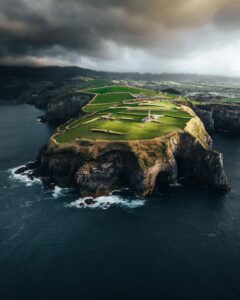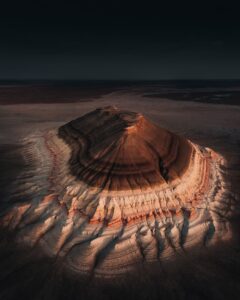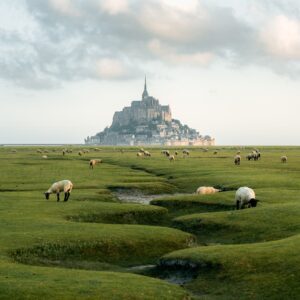
Photo tour in Azores, Portugal
Join us in the Azores for a unique photo tour, where you’ll elevate your creative skills with expert guidance from Ronald Soethje, Bruno Ázera, and Nomadict.
This iconic cabin is located in the unique Dolomites mountain range in Italy. Inspired by autumn, I knew that visiting the mountains during this season would be magical. If you have autumn images in your archive that you want to edit, here is a breakdown of my workflow for you to learn from.
Step 1) Timing
I aimed for the cabin to be gently illuminated by the sunrise, preserving its details and natural colors without being overwhelmed by golden light. Sunrises and sunsets at their zenith can often cast harsh red or orange hues that complicate editing and stray from the original vision.
Step 2) Composition
There’s no greater satisfaction than achieving your vision directly through the camera. In this instance, I positioned myself low to the ground, shooting from a slight upward angle. My goal was to accurately capture the cabin, highlighting its angles and textures while maintaining a clean image. It’s crucial to consider your foreground, middle ground, and background when composing your shots.
Step 3) Camera settings
35MM, 1/80 shutter speed, f/2.8, ISO 100.
Step 4) Basic adjustments
In general, I aim to leverage colors and light effectively. In this instance, I aimed to maintain a natural edit while enhancing the richness and dreamy atmosphere of the image. For instance, I reduced clarity settings (-24) and increased dehaze (+37) to deepen the tones of browns and yellows. Adjusting saturation and hues of specific colors can enhance their tones effectively.
4.1) White balance
Temperature 11,308
Tint +4
4.2) Tone
Exposure +0.20
Contrast +22
Highlights -73
Shadows +80
Whites +1
Blacks +12
4.3) Presence
Texture +3
Clarity -24
Dehaze +37
Vibrance -9
Saturation +35
Step 5) S curve
I applied four points to my curve, as seen in the image, to adjust the highlights and shadows to my liking.
Step 6) Color mixer
6.1) RAW
The color palette from the RAW file features a very light gray (F4F7FA), a dark brown (403929), a very dark gray (1E1C16), a medium gray (53585B), and a light brown (AD8B5A).
Thus, I applied the following adjustments to get closer to my vision:
6.2) Hue
Red +24
Orange +8
Yellow -24
Aqua -4
Blue -15
6.3) Saturation
Red -39
Orange -61
Yellow -72
Green -62
Aqua -25
Blue -74
6.4) Luminance
Red -20
Orange -20
Yellow +3
Green +1
Aqua +12
Blue +53
6.5) Edited colors
The edited color palette includes light beige (D6CFC4) for the sky – one of the most significant changes in color in the image, medium brown (765231), muted taupe (9D876E), dark brown (35291C), and dark taupe (645747). All these colors are close to each other on the color wheel within the brown/earth tone spectrum, making this an analogous palette that helps create a harmonious and cohesive look.
Step 7) Masking
You can easily over-edit this step, so you need to make micro-adjustments. I tend to desaturate my skies and bring down the whites as well as bring down clarity and dehaze to soften the look, giving it that dreamy feel.

Join us in the Azores for a unique photo tour, where you’ll elevate your creative skills with expert guidance from Ronald Soethje, Bruno Ázera, and Nomadict.

In this article, Forest shares how years of chasing scale, silence, and raw landscapes shaped his approach to photography, from the deserts of Kazakhstan to the volcanic ridges of Iceland. He talks about how he uses light, texture, and vast negative space to create images that feel both intimate and overwhelming.

Simon shares the journey behind his photography, from early inspirations to field techniques, editing, and the story of the winning shot that shaped his path.

In this article, Miro shares how his love for cinematic music evolved into a deep passion for photography and how he uses light, color, and atmosphere to turn the streets of Prague into living film scenes.

In this article, Stefanie reveals how her background in physics sparked her passion for astrophotography and how she blends science with creativity to capture the beauty of the night sky. Readers will discover her approach to color, contrast, and editing, as well as her aurora photography workflow.

Spanish photographer Yhabril captures the profound connection between humans and the mountains that shaped him. Growing up in the Pyrenees, his work bridges outdoor sports, landscapes, and celestial scenes — often blending athletes, moonlight, and wilderness into striking visual stories.

In this article, Ariane shares how photography helped her navigate personal challenges, connect authentically with people and animals, and develop a philosophy rooted in empathy and artistic freedom. Readers will also discover her ethical approach to wildlife photography and her trusted equipment for both camouflage techniques and cameras.

Discover how to photograph Dutch tulip fields in their most magical light. From choosing the right gear and lenses to mastering composition, color, and aerial perspectives, this guide shares creative techniques to capture the beauty of the Netherlands’ tulips. Learn how light, color grading, and proportion bring emotion into every frame.
